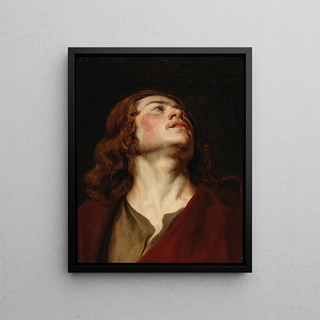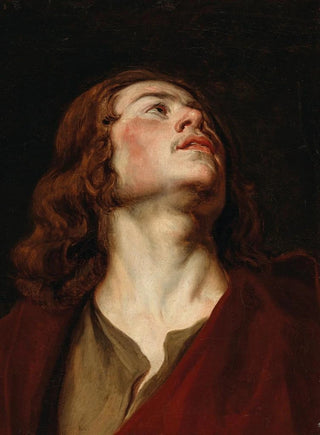Art print | Saint Jean l'Évangéliste - École d'Antoine van Dyck


View from behind

Frame (optional)
Saint John the Evangelist - School of Antoine van Dyck – Captivating Introduction
The art print of Saint John the Evangelist - School of Antoine van Dyck immerses us in the fascinating world of baroque art, where light and shadow meet to create scenes of dramatic intensity. This painting, emblematic of Van Dyck's mastery, evokes not only Christian spirituality but also the emotional richness that characterizes his work. The image of Saint John, often depicted with a quill and a book, embodies wisdom and reflection, while also bearing witness to the significant events of Christ's life. This artwork invites the viewer to deep contemplation, an immersion into the religious and artistic thought of the 17th century.
Style and uniqueness of the work
Van Dyck's style is distinguished by its ability to combine realism with a certain idealization of human figures. In this piece, every detail is carefully considered, from Saint John's facial expression to the texture of the garments, which seem almost tangible. The colors, rich and luminous, create an atmosphere that is both soothing and vibrant. The composition is balanced, highlighting the main character while incorporating symbolic elements that enrich the visual narrative. The mastery of light, typical of baroque art, plays a crucial role in emphasizing the central figure, while the blurred background enhances the depth of the work. This uniqueness makes each viewing of the painting a singular experience, evoking a range of emotions and reflections on the divine nature.
The artist and his influence
Antoine van Dyck, a pupil of Rubens, established himself as one of the greatest portraitists of his time, but also as a painter of religious scenes with great depth. His influence extends far beyond his era, impacting generations of artists who admire his ability to capture human essence while incorporating elements of spirituality. Thanks to his stay in England, he also helped shape aristocratic tastes for portraiture and religious painting. His innovative approach paved the way for numerous artistic movements, and his legacy endures in the history of art.

Matte finish

View from behind

Frame (optional)
Saint John the Evangelist - School of Antoine van Dyck – Captivating Introduction
The art print of Saint John the Evangelist - School of Antoine van Dyck immerses us in the fascinating world of baroque art, where light and shadow meet to create scenes of dramatic intensity. This painting, emblematic of Van Dyck's mastery, evokes not only Christian spirituality but also the emotional richness that characterizes his work. The image of Saint John, often depicted with a quill and a book, embodies wisdom and reflection, while also bearing witness to the significant events of Christ's life. This artwork invites the viewer to deep contemplation, an immersion into the religious and artistic thought of the 17th century.
Style and uniqueness of the work
Van Dyck's style is distinguished by its ability to combine realism with a certain idealization of human figures. In this piece, every detail is carefully considered, from Saint John's facial expression to the texture of the garments, which seem almost tangible. The colors, rich and luminous, create an atmosphere that is both soothing and vibrant. The composition is balanced, highlighting the main character while incorporating symbolic elements that enrich the visual narrative. The mastery of light, typical of baroque art, plays a crucial role in emphasizing the central figure, while the blurred background enhances the depth of the work. This uniqueness makes each viewing of the painting a singular experience, evoking a range of emotions and reflections on the divine nature.
The artist and his influence
Antoine van Dyck, a pupil of Rubens, established himself as one of the greatest portraitists of his time, but also as a painter of religious scenes with great depth. His influence extends far beyond his era, impacting generations of artists who admire his ability to capture human essence while incorporating elements of spirituality. Thanks to his stay in England, he also helped shape aristocratic tastes for portraiture and religious painting. His innovative approach paved the way for numerous artistic movements, and his legacy endures in the history of art.






